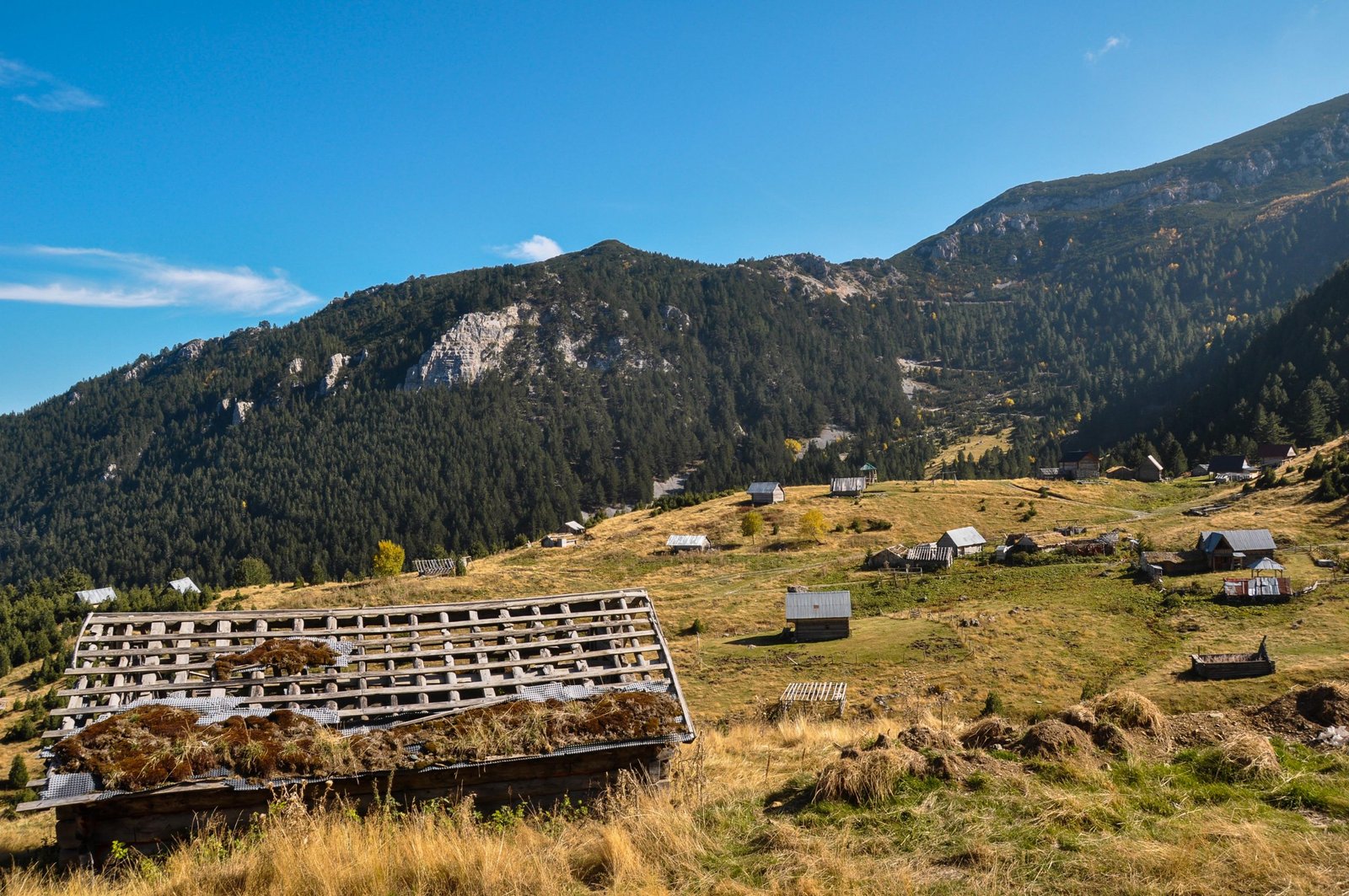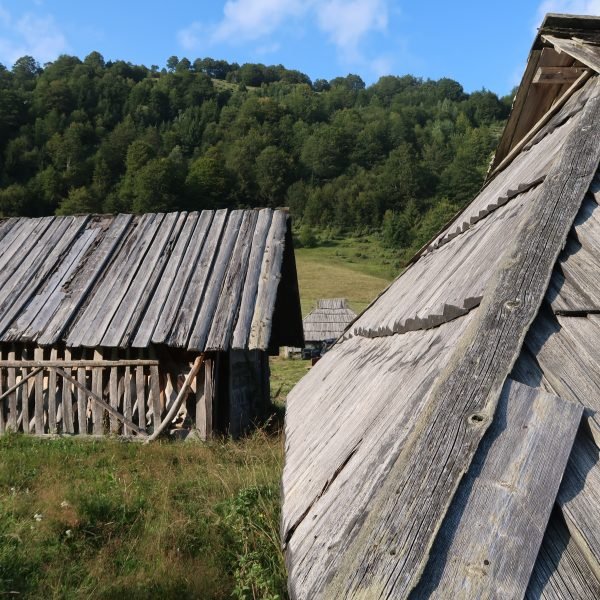Architecture
The overall human history has had a period where a big portion of its survival depended on shepherds farming different types of animals. And the region of the Accursed Mountains is no different. The specific geographical position, terrain, individual history and development have influenced many aspects of life: relocation patterns, the animals that people chose to farm, the architecture and the building materials. Different locations have different climatic conditions, temperatures, wind intensity, precipitation (rain and snow), and so these different parameters determined different types of structures, especially the shapes of the roofs, in order to achieve the stability of the buildings, the most favourable thermal comfort, with a rational and economical consumption of energy for heating or cooling.
Old traditional houses in this area were usually constructed on a stone foundation and then from different wood materials on top of this foundation. They were usually of a very ascetic form with either a wood-shingled or stone-shingled rooftop, with incised gables or of a pyramidal shape. Houses with these features belong to a wider type of Balkan mountain family houses. People said that these houses just popped out from the very places they were located in, but here the word “place” meant, not just the position, but also the very mixture of nature, people and their customs. Different types of architecture are usually interpreted through form and materials. But in order to make good architecture, in addition to form and materials, insight into social and ethnological topics related to the area is of great help.
The traditional, folk arhitecture
Folk architecture is immensely important part of cultural landscape. Through the folk architecture itself, you can clearly see what the conditions were like for a man who built a house for himself, for example. You will also know more about the materials he was surrounded by, that is the reason we have stone houses at the seaside and wooden houses in the mountains. The roof tilt shows what the climate is like – a honed tilt means more precipitation. Space layout shows the main economic activities of the household. Details show which building technology was used by the homeowner. A large number of things about a person can be discovered just by looking at the house he had built, and the way he organized his property. Perhaps the most important lesson that can be learned by looking at these old houses is that our ancestors, as limited in tools, technology and means of transport as they were, made objects from the local materials, harmonized with the surrounding area, and took care not to destroy the environment irreparably, a lot more than we do. They also tried not to take more than was necessary from the nature but to use it as much as they needed, paying attention not to harm it too much.
When folk architecture of this region is concerned, natural wealth but also the difference in ethnic groups that lived and still live here, have influenced the fact that we have a substantial heritage in this field, as well as many traditional buildings that can be seen in almost every village even today.
Kula (Towers)
The stone towers that can be seen in the area within and close to the Accursed Mountains differ from the predominant types of houses in other regions. Their exterior and structure and spatial organization were adapted to what can be considered as more military and defence requirements. They are essentially simple, metrically clean, without large openings, with a steep shingled roof. Later they became a symbol of wealth and power of the families, so the need to preserve them throughout the centuries remained a priority for these families. Sometimes even ordinary houses were dubbed as “kula (towers)” if they belonged to people of a higher social standing. Today, they have merged into the landscape, as they are scattered between old and newly built houses that typologically do not belong to the architectural style of this region. Some of the kulas (towers) are still inhabited, but usually nowadays people refrain from living in them as their defensive function ceased to be important to the modern people. But it was this function and their continuous remodelling that expanded on their originally ascetic interior. Luckily some people recognised this unique atmosphere and brought some of these towers back to their former glory. In some cases such kulas (towers) were transformed into restaurants and inns in this regions, which offer a uniquely attractive environment for tourists, which together with traditional dishes served, enable them to experience the traditional ways of living in such houses and the region.
Katuni – Mountain shepherd villages
When it comes to the origin of the katun villages the most popular opinion is that they are seasonal, usually summer livestock settlements, where people move to with their livestock to provide more food and avoid the heat during the summer months. There are other opinions but it all comes down to the fact that the “katuni” villages were related to animal husbandry, not only in the Accursed Mountains region but in the entire Balkan Peninsula. The term itself, katun, was first mentioned in the 15th century. The interesting part is that these villages, were, and still are closely linked to the origin of the families and tribes that inhabited them. It was always known which tribe will go with their livestock to which village. And they never changed them, even though there were no written documents proving ownership of any of the houses, huts, meadows, forests, etc… Sometimes even the kings “granted” parts of different mountainous regions to different tribes for outstanding merits, usually during or after times of war. It was never an easy job to choose the right katun since there was a lot at stake. The shepherds had to consider many details: how many days would be needed to get there with all the livestock (there were no trucks, it was all done on foot), would there be enough food for the animals, a nearby spring or other sources of water, etc… And after they chose the most favourable locations, the construction of the required facilities began , which included different types of mountain houses, sheep holds, shade-areas for the livestock, etc…
Shepherds
The story of the katun villages wouldn’t be complete without mentioning the shepherds. Their main preoccupation was (is) to take care of their flock with the utmost care and to protect it from wild animals, primarily wolves, and thieves. There are many folk songs about shepherds, and how their watchful eye was always alert, either when the sheep graze peacefully or when they are threatened by something. Even at night, the shepherds are on guard. They usually sleep in a hut near the sheep hold. They also pay special attention when the sheep are giving birth and a good and experienced shepherd will always know which lamb is from which sheep. They are the ones that choose which rams to let into the herd so that the new generation of lambs will be the best one possible. Also, shepherds are the ones who choose the best ram that will carry the bell – čaktar/troke – and such a ram was always highly valued with a special price and even got honourably mentioned in many folk songs.
Livestock
In these regions, it is said that a man’s wealth is in his livestock. When someone asked the people about their living conditions they would often reply “We live on cattle” and that meant that they lived good. Consequently, the main concern was how to maintain the livestock either in terms of reproduction or in terms of providing daily food. For the people from this region in Montenegro, it was easier to be shepherds than to crop fields in the karst terrains of the northern mountains. In the coastal areas where there were small forests where the cattle could feed on buds not too much attention was paid to grazing or wintering for the livestock. But if the herds were more numerous and the winters six months long, it was not easy to provide nutrition. Nonetheless, hardworking people managed in various ways, even to the point of cutting leaves from oak, ash or other trees and adding it to the food. On the Kosovo side, most of the families that originated from these mountain villages had properties in the fertile flatlands below, where they would cultivate crops and live during winter, and also protect their livestock from harsh weather, and then move the animals to the mountain villages in the summer. In truth, people had multiple benefits from their livestock. Even today you can hear them say that the sheep is a blessed animal. Milk, wool, meat, lambs and skin were obtained from it. Cows produced milk, meat, calves as well as labour-power, goat milk, meat, and skin whereas horses, mules and donkeys were kept for labour without which life in the countryside couldn’t be imagined. Also, animal products were exchanged either for money or in kind, providing other necessities for everyday life.
Cultural routes
When talking about cultural routes in this part of the world it has to be mentioned that throughout history there were many different cultural influences, some that lasted for over 400 years. Today this region is a unique mosaic of Illyrian, Roman, Byzantine, Ottoman, Venetian, Austria-Hungarian, and Yugoslav eras and the evidence of this fusion can be seen in many areas of everyday life. So when going on a cultural route you should know what to expect and here you can expect a lot. Also, many of these routes are cross border routes that can take you to Montenegro, Albania, Kosovo, Serbia, Bosnia and Herzegovina, Northern Macedonia or even Croatia so they can be expanded and connected with all of the neighbouring countries into an overall experience of the Balkans. What many people are just starting to discover is the diversity of this landscape – from sandy beaches on the Adriatic to the spectacular mountain ranges that are part of the Dinaric Alps, with villages tucked below snowy peaks offering plenty of different activities.










